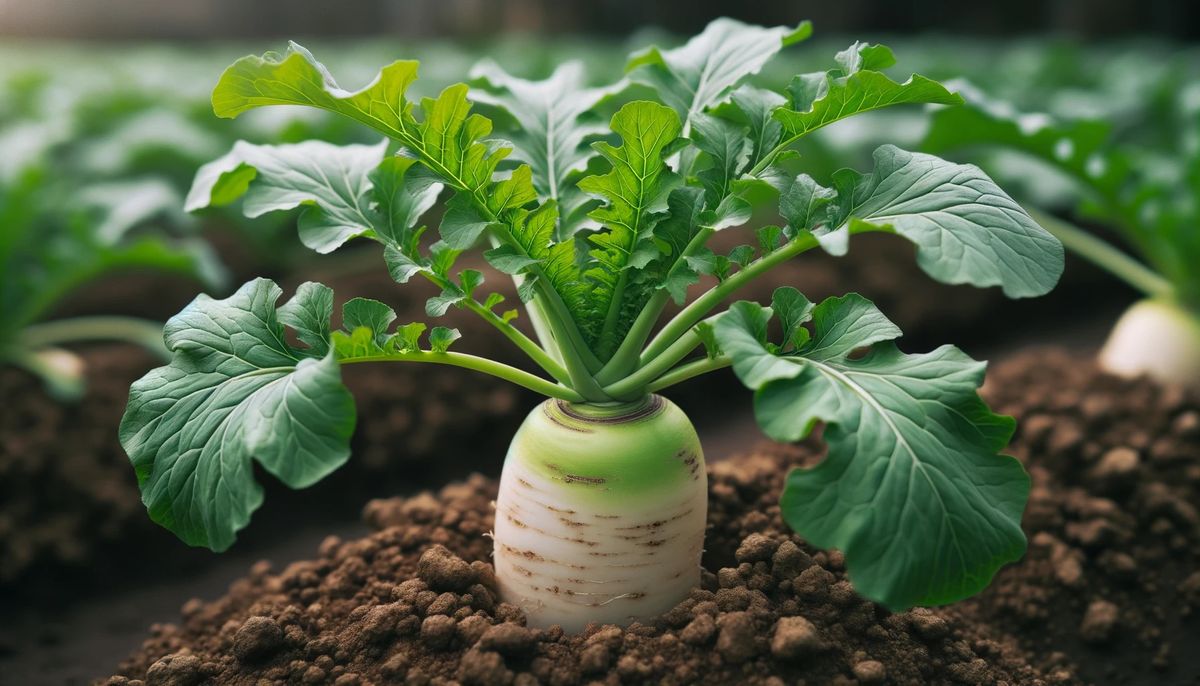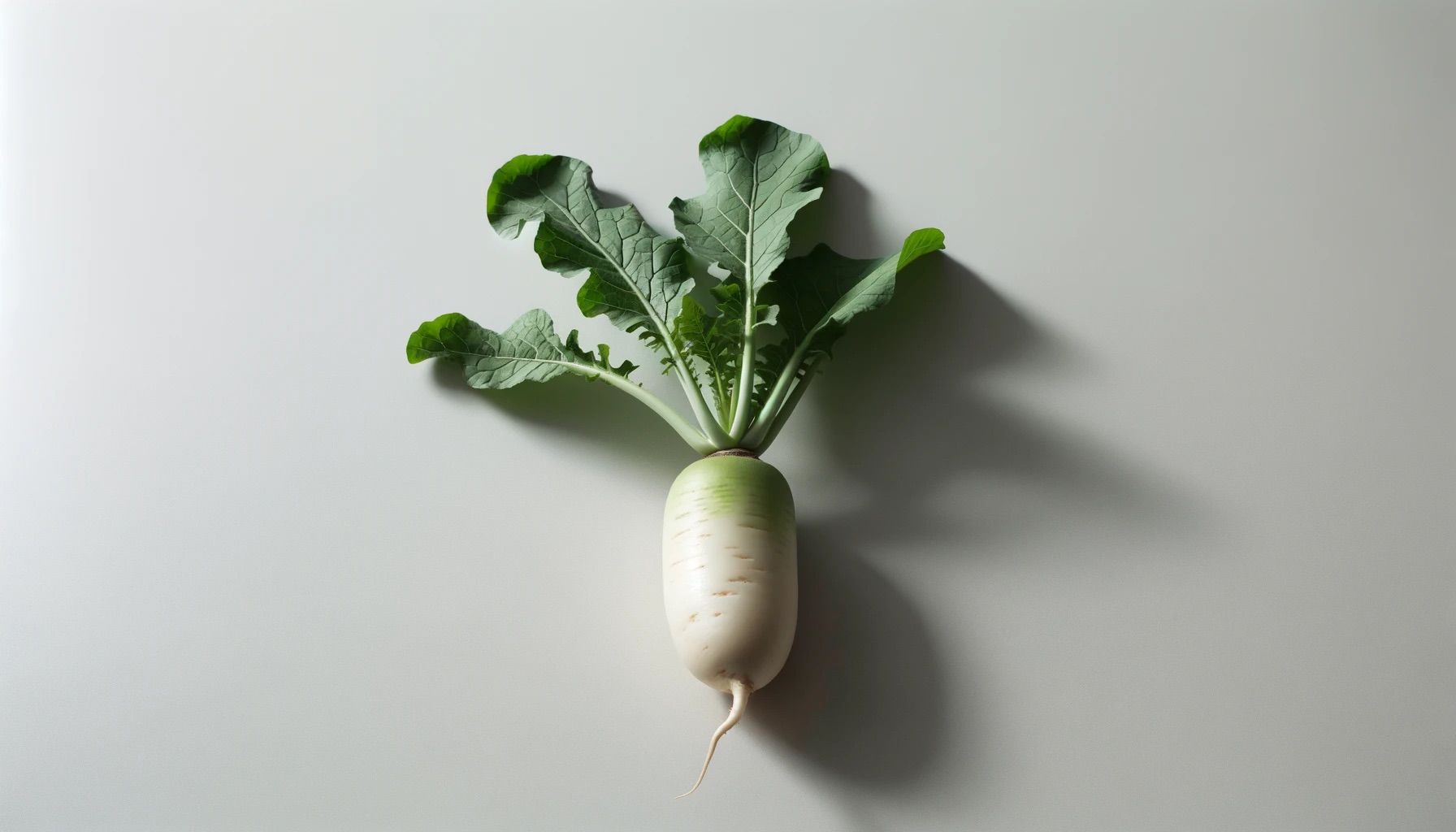How to Grow Daikon Radish
Explore our comprehensive guide to mastering Daikon Radish cultivation, offering insights from planting seeds to overcoming common pests and diseases, perfect for enthusiasts of organic daikon farming.

Table of Contents
To ensure a successful harvest, it's important to plant daikon seeds at the right time and provide optimal growing conditions.
Generally, daikon thrives in cool weather, so planting in late summer or fall is recommended.
Remember that these radishes typically mature in 60 to 70 days, so plan accordingly.
About Daikon Radish
Daikon radish (Raphanus sativus var. longipinnatus), also known as white radish, winter radish, Chinese radish, Japanese radish, or Chinese turnip, is a large root vegetable commonly used in Asian cuisine.
This versatile root vegetable is a member of the Raphanus family, and its mature, elongated roots can be crisp, sweet, or slightly spicy, depending on the variety.

Daikons thrive in a pH range of 6.0 to 7.0 and prefer rich, loose, well-draining soil.
You can grow daikon radishes easily by direct planting, considering factors such as temperature range, sunlight preferences, depth, spacing, and watering requirements.
Opt for a sunny spot in your garden and plant them between slower-to-sprout plants, as they grow quickly and can be harvested before the other plants need the space.
Beyond its culinary versatility, the Daikon Radish boasts a plethora of health benefits.
Rich in vitamins, minerals, and antioxidants, it's an excellent dietary choice for promoting digestive health and boosting the immune system.
Furthermore, Daikon Radish is ideally suited for organic farming. Its robust nature and adaptability to diverse soil conditions make it a perfect candidate for sustainable agriculture practices.
By opting for organic daikon farming, gardeners can enjoy not only a bountiful harvest but also contribute to environmentally friendly gardening, ensuring healthier and more natural produce.
Growing Daikon Radish
Growing Daikon Radish successfully requires understanding its preference for cooler weather, making late summer or early fall the ideal planting time.
To optimize your efforts in growing Daikon Radish, prepare your garden bed with well-draining soil, maintaining a soil temperature around 60-70°F (15-21°C).
Sowing the seeds at a depth of 3/4 inch (2cm) and spacing them 6 inches (15cm) apart, leaving 3 feet (91 cm) between rows for mature spread while ensuring full sun exposure, are vital steps.
These considerations are crucial in growing Daikon radishes, as they mature within 60 to 70 days, promising a nutritious and tasty addition to your garden bounty.
Prepare your garden bed or raised beds with well-draining soil, ensuring the soil temperature is around 60-70°F (15-21°C) for optimal growth.

Caring for Daikon Radish
Sun and Temperature
Provide your daikon radish plants with full sun for optimal growth. They grow best in temperatures below 80 degrees F (27 C).
Water and Humidity
Install a drip irrigation system for consistent watering, and apply a 1-inch (2.5 cm) layer of mulch around the plants to conserve moisture.
Ensure the soil is moist, neither overly saturated nor too dry.
Soil
Choose a rich, loose, well-drained soil for your daikon radishes. Ensure the soil has a pH between 5.8 and 6.8 for optimal growth conditions.
Fertilizer
Apply a balanced fertilizer, avoiding excessive nitrogen, which may cause top growth at the expense of root development.
A slow-release organic fertilizer can be a good choice.

Repotting
If you're growing daikon radishes in a container, ensure it has good drainage.
You may need to repot the plant if the roots outgrow the container, ensuring it has adequate space for growth.
Pruning and Propagation
Thin radish seedlings to a spacing of 3 inches (7.6 cm) apart to give them ample room to grow.
It is unnecessary to prune daikon radishes, and propagation can be done by directly planting seeds into the garden or container at the appropriate depth and spacing.
Troubleshooting Plant Problems
Growing Problems
To ensure successful daikon radish growth, plant them in loose, well-drained soil and full sun or partial shade if the weather is warm.
Avoid compacted or clay-rich soil that results in stunted root development and low germination rates.
Be aware of common growth problems such as cracked, deformed, or small roots and address them by providing the right growing conditions.
Pests and Diseases
Daikon radishes can be affected by various pests and diseases. Common insect pests include flea beetles, cabbage maggots, and harlequin bugs.
Watch for diseases like root rot, Alternaria blight, white rust, and downy mildew.
To combat these issues, choose disease-resistant varieties, maintain healthy soil, and practice good garden hygiene.

Companion Planting
Companion planting can help protect your daikon radishes from pests and diseases while promoting healthy growth.
Plant radishes near crops that offer natural protection, such as marigolds (repel pests).
Be cautious about planting near crops that attract similar pests or diseases to avoid problems spreading across your garden.
Conclusion
Daikon radishes are a versatile and highly nutritious vegetable ideal for Asian cuisine and numerous recipes, such as pickling, cooking, and even using as microgreens.
With a growth maturity of 60 to 70 days, you'll have plenty to harvest, store, and utilize in your cooking endeavors.
Make the most of this impressive vegetable by incorporating daikon in your garden and practicing crop rotation.
As a bonus, daikon radishes are an excellent cover crop and mulch, contributing to soil health and recycling nutrients for future growth.
Embrace the long, edible roots of daikon radishes and enjoy their many benefits.
Frequently Asked Questions
When to harvest daikon radish?
Daikon radishes are typically ready for harvest 60 to 70 days after planting.
You can harvest them when the roots reach about 2 inches in diameter and at least 8 inches in length.
What zone is best to plant daikon radish?
Daikon radishes can be cultivated in most areas across the United States.
They grow well in USDA hardiness zones 2 to 11, with cool weather optimal for their growth.
How long does it take for daikon radishes to grow?
Daikon radishes usually take between 60 to 70 days to reach maturity.
Due to their larger size, this is longer than the typical growth period of other radish varieties.
Do daikon radishes prefer sun or shade?
Daikon radishes prefer full sun for healthy growth. However, they can tolerate light shade, especially in hot summers or intense afternoon sun exposure.
How can I grow daikon radishes at home?
To grow daikon radishes at home, plant the seeds in rows, spacing them about 4 to 6 inches apart and at a depth of around 1/2 inch.
Keep the soil consistently moist but not waterlogged, and ensure they receive adequate sunlight.
What temperature is ideal for daikon radish growth?
The ideal temperature range for growing daikon radishes is between 60 to 70°F (16 to 21°C).
They prefer cool weather conditions and may become pithy or develop a stronger flavor if exposed to excessively high temperatures.



